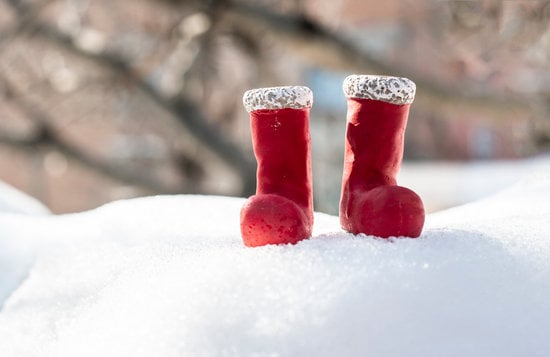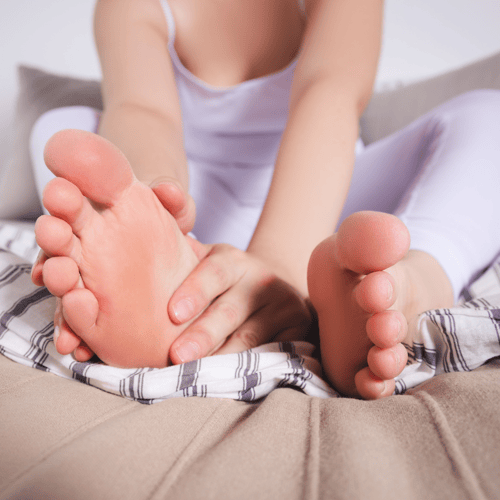
When the days get shorter and shorter, the mornings turn foggy and frosty, and the geese begin honking their way overhead, you know that winter is truly setting in.
While the joys of winter are numerous from the sights, sounds, and smells of Christmas to cozy fires and cups of hot chocolate to romping in fresh fallen snow, this is also a time of the year when the harsh elements can take a toll on your body, especially your feet and toes.
The reality is that your lower extremities can bear the brunt of cold temperatures, posing unique challenges for those already grappling with food conditions and ailments.
"During the winter months, patients should take extra precaution to keep their feet warm and dry when navigating frigid temps, especially patients who have existing health conditions," foot and ankle surgeon and American College of Foot and Ankle Surgeons (ACFAS) Fellow Member Greg Catalano, DPM, FACFAS, told the ACFAS.
Why Winter is Tough on Feet
Winter is tough on feet with people who must work outside or those who do outdoor activities prone to suffering cold-weather injuries and ailments.
“With prolonged exposure to cold weather, your feet are often the first part of the body to feel the uncomfortable effects. To keep our core body temperature stable, blood vessels within our arms and legs will constrict (narrow), which is why they're the first parts of our bodies to get cold when temperatures drop,” explains Very Well Health. “Cold weather injuries such as frostbite are a high risk for people who work outdoors during the winter or engage in outdoor winter activities. These injuries can range from mild to severe, with some of the more serious cases requiring amputation and rehabilitation.”
Winter means woes for your toes for several reasons:
- Cold Temperatures and Circulation: The body naturally prioritizes keeping vital organs warm during cold weather, which can lead to decreased blood flow to the extremities. This reduced circulation affects the feet, making them more susceptible to various issues.
- Dry Indoor Air: Heated indoor environments during winter tend to have low humidity levels, contributing to dry skin. Cracked and dry skin on the feet can create entry points for bacteria, fungi, and infections.
- Footwear Choices: To stay warm, people often opt for heavy, insulated footwear. Bulky boots and layers can compress your feet, restricting movement and increasing friction. While these choices provide warmth, they may lack proper ventilation, leading to moisture accumulation and potential fungal infections.
Common Foot Problems Seen by Providers in Winter
Here are some common foot problems seen by providers in the winter months:
- Chilblains: Prolonged exposure to cold and damp conditions may lead to chilblains, characterized by red, swollen, and itchy bumps, lumps, and patches on your skin.
- Dry, Cracked Skin: Cold weather and low humidity can result in dry, flaky skin on the feet. Your flaky feet lead to painful fissures.
- Frostbite: Extreme cold can cause frostbite, which occurs when the skin and underlying tissues freeze. This can lead to permanent damage if not addressed promptly.
- Fungal Infections: Athlete's foot thrives in warm, moist environments like sweaty boots.
- Exacerbation of Pre-existing Conditions: Bunions, hammertoes, and plantar fasciitis can flare up due to restricted movement and cold temperatures.
- Increased Risk for Infections: Cracks in dry skin, combined with moist conditions inside winter footwear, create a breeding ground for infections like athlete's foot and fungal nail infections.
- Morton’s Neuroma: Those suffering from this neuropathy, an inflammation on one of the nerves in your feet, often complain that the condition worsens in colder weather.
- Peripheral Arterial Disease (PAD): Reduced blood flow to the extremities can exacerbate symptoms in patients with PAD, leading to pain and discomfort.
- Raynaud’s Disease: Raynaud's disease (also known as Raynaud’s phenomenon or Raynaud syndrome) causes some areas of the body — such as fingers and toes — to feel numb and cold in response to cold temperatures or stress, according to the Mayo Clinic. Women are more likely than men to have Raynaud's disease. It seems to be more common in people who live in colder climates.
- Trench Foot (Immersion Foot): Prolonged exposure to damp and cold conditions, often exacerbated by wet footwear, can lead to trench foot. This condition is similar to frostbite but occurs at temperatures above freezing. Trench foot may cause numbness, tingling, pain, and swelling. In severe cases, it can lead to blistering and tissue damage.
Protecting Your Feet This Winter:
We don’t expect you to stay inside all winter with your toes warming by the fireplace, so here are some tips to maintain optimal foot health during the winter months:
- Hydration: Keep your feet moisturized to prevent dry skin. Use a good-quality foot cream regularly.
- Proper Footwear: Choose well-insulated, waterproof boots with proper ventilation. Change out of wet socks promptly to prevent fungal infections.
- Warm-Up Exercises: Before heading outdoors, perform simple foot exercises to improve circulation and keep your feet warm.
- Regular Inspections: Check your feet daily for any signs of redness, swelling, or injury. Early detection can prevent more serious issues.
- Layering Socks: Consider wearing moisture-wicking socks as a base layer to keep your feet dry and warm. Note: Make sure you choose your socks wisely with natural fibers like wool or merino wool best for warmth and moisture wicking.
- Avoid Tight Footwear: Tight shoes can impair circulation. Ensure your footwear allows room for movement and doesn't constrict blood flow.
- Schedule Regular Foot Checkups with Your Provider: If you have diabetes or another condition affecting your feet, consult your doctor for regular checkups to monitor for any issues early on.
- Listen to Your Feet: Don't ignore pain, numbness, or tingling. These could be signs of a more serious problem.
By understanding the unique challenges winter poses for your feet and implementing these protective measures, you can prevent painful woes and keep your toes toasty and trouble-free all season long.
Remember, a little extra care can go a long way in ensuring your feet stay in top condition during any season, but it’s especially important during the cold winter months.
And if you do run into foot or ankle discomfort this winter, contact Sweeney Foot & Ankle Specialist in Magnolia and The Woodlands for help getting you back on your feet.






